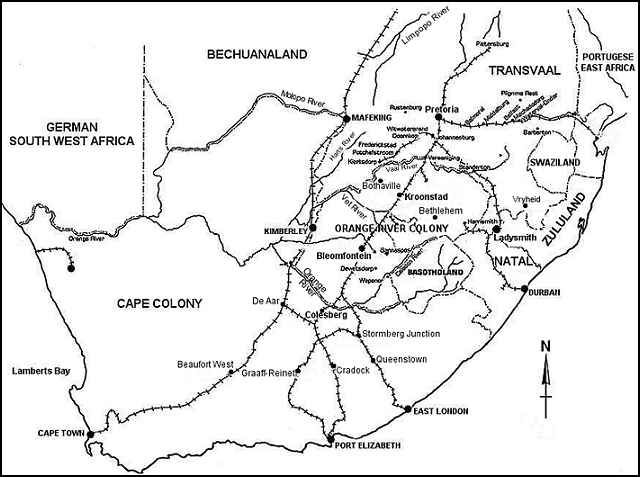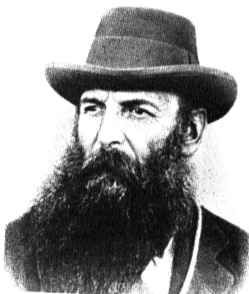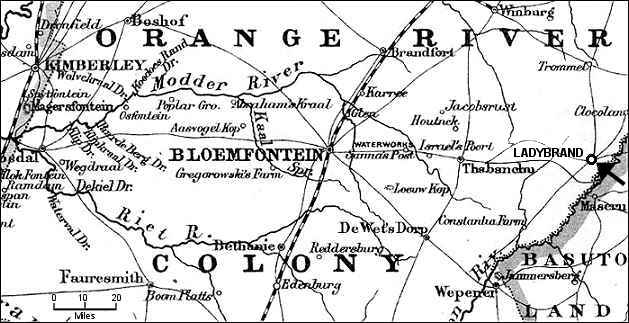Boer War 1900-1902
During the Boer War both the 1st and 2nd Battalions of the Worcestershire Regiment were in actions between 1900 to 1902. The 6th Battalion (Militia) also joined the British Army in South Africa in January 1902. Below is a brief account of the actions of the Worcestershire Regiment battalions in South Africa between 1900 - 1902. The 2nd Battalion was the first to arrive in South Africa.
2nd BattalionOn the 17th December 1899 the men of the 2nd Battalion Worcestershire Regiment embarked at Southampton on the troop ship 'Tintagel Vastle' and headed for the war in South Africa as reinforcements for the British Army under Field Marshal Lord Roberts. On the 8th January 1900 the 2nd Battalion disembarked at Cape Town and then made their way north towards the town of Rensburg where Lieut.-General Clements was holding back the Boers who were now concentrated at Colesberg some 10 miles north of the British line. The 2nd Battalion Worcesters now joined General Clements Brigade together with the 1st Royal Irish and the 2nd Battalion Wiltshires. The British line still laid in a semicircle extending from Slingersfontein upon the right to Kloof Camp upon the left, and the general scheme of operations continued to be an enveloping movement upon the right. General Clements commanded this section of the forces on the right. The British lines had gradually stretched until they were now nearly fifty miles in length. |
Lieut-General Clements |
South Africa (1900-1902) |
The Boer generals do not favour night attacks, but they are exceedingly fond of using darkness for taking up a good position and pushing onwards as soon as it is possible to see. This is what they did upon this occasion, and the first intimation which the outposts had of their presence was the rush of feet and loom of figures in the cold misty light of dawn. The occupants of the sangars were killed to a man, and the assailants rushed onwards. As the sun topped the line of the veldt half the kopje was in their possession. Shouting and firing, they pressed onwards. But the Worcester men were steady old soldiers, and the battalion contained no less than four hundred and fifty marksmen in its ranks. Of these the companies upon the hill (later named Worcester Hill) had their due proportion, and their fire was so accurate that the Boers found themselves unable to advance any further. Through the long day a desperate duel was maintained between the two lines of riflemen. |
The Worcestershire Commander Lieut.- Colonel Charles Cuningham and his second in command Brevet- Major Arthur Kennedy Stubbs were killed while endeavouring to recover the ground which had been lost. Hovel and Bartholomew continued to encourage their men, and the British fire became so deadly that that of the Boers was dominated. Under the direction of Hacket Pain, who commanded the nearest post, guns of J battery were brought out into the open and shelled the portion of the kopje which was held by the Boers. The latter were reinforced, but could make no advance against the accurate rifle fire with which they were met. The Bisley champion of the battalion, with a bullet through his thigh, expended a hundred rounds before sinking from loss of blood. It was an excellent defence, and a pleasing exception to those too frequent cases where an isolated force has lost heart in face of a numerous and persistent foe. The Worcestershire Commander Lieut.- Colonel Charles Cuningham and his second in command Brevet- Major Arthur Kennedy Stubbs were killed while endeavouring to recover the ground which had been lost. Hovel and Bartholomew continued to encourage their men, and the British fire became so deadly that that of the Boers was dominated. Under the direction of Hacket Pain, who commanded the nearest post, guns of J battery were brought out into the open and shelled the portion of the kopje which was held by the Boers. The latter were reinforced, but could make no advance against the accurate rifle fire with which they were met. The Bisley champion of the battalion, with a bullet through his thigh, expended a hundred rounds before sinking from loss of blood. It was an excellent defence, and a pleasing exception to those too frequent cases where an isolated force has lost heart in face of a numerous and persistent foe. With the coming of darkness the Boers withdrew with a loss of over two hundred killed and wounded. Orders had come from General Clements that the whole right wing should be drawn in, and in obedience to them the remains of the victorious companies were called in by Hacket Pain, who moved his force by night in the direction of Rensburg. The British loss in the action was twenty-eight killed and nearly a hundred wounded or missing, most of which was incurred when the sangars were rushed in the early morning. |
General De la Rey |

2nd Battalion Worcesters at Worcester Hill (Kopjes) near Slingersfontein (12th February 1900)
(The RED line shows the British front line and the GREEN line the Boers front line.)
2nd Battalion Worcestershire officers and other ranks, killed in action or died of wounds.
Surname |
Forename/s |
Number |
Rank |
Cause of Death |
Died |
Cuningham |
Charles |
- |
Lieut.-Col. |
Killed in Action |
12/02/1900 |
Stubbs |
Arthur Kennedy |
- |
Brevet-Major |
Killed in Action |
12/02/1900 |
Thomas |
Berkeley Hardinge |
- |
Captain |
Died of Wounds |
20/02/1900 |
Allen |
J. |
3656 |
L\Cpl. |
Killed in Action |
12/02/1900 |
Bennitt |
W. |
4887 |
Pte |
Killed in Action |
12/02/1900 |
Carrington |
J. |
4203 |
Pte. |
Killed in Action |
12/02/1900 |
Carter |
W. E. |
4068 |
Sgt. |
Killed in Action |
12/02/1900 |
Crumpton |
A. |
2834 |
Pte. |
Died of Wounds |
- |
Danks |
F. |
3086 |
Pte. |
Killed in Action |
12/02/1900 |
Deverill |
F. |
4672 |
Pte. |
Killed in Action |
12/02/1900 |
Lammas |
A. |
2851 |
Pte. |
Killed in Action |
12/02/1900 |
Mason |
W. |
4292 |
Pte. |
Killed in Action |
12/02/1900 |
McNaughton |
J. |
3782 |
Pte. |
Killed in Action |
12/02/1900 |
Morris |
J. |
2803 |
Pte |
Killed in Action |
12/02/1900 |
Parker |
A. |
4093 |
Pte. |
Killed in Action |
12/02/1900 |
Parton |
J |
3213 |
Pte. |
Killed in Action |
12/02/1900 |
Pimm |
W. |
4918 |
Pte. |
Killed in Action |
12/02/1900 |
Pritchard |
J. |
4232 |
Cpl. |
Killed in Action |
12/02/1900 |
Turley |
A. |
4565 |
Pte. |
Killed in Action |
12/02/1900 |
Turley |
A. |
4565 |
Pte |
Killed in Action |
12/02/1900 |
Watkins |
E. |
2558 |
Sgt. |
Killed in Action |
12/02/1900 |
Weissner |
W. |
3935 |
Pte. |
Killed in Action |
12/02/1900 |
Wheeler |
|
4383 |
Pte. |
Died of Wounds |
- |
Wheelerone |
O. |
4383 |
Pte |
Killed in Action |
12/02/1900 |
Note: Private Crumpton and Private Wheeler who died later of their wounds were buried at the cemetery at Springfontein. Theirs names do not appear on the Worcester Hill Memorial.
The inscription on the Worcester Memorial at Worcester Hill, Yardley Farm is as follows:
"FIRM"
"In Memory of the following Officers, N.C.O's and Men of the 2nd Batt. (36th) Worcestershire Regiment who were killed in action or died of wounds, received in action near this spot while doing their duty defending this position on 12th February 1900..............followed by the names of the men"

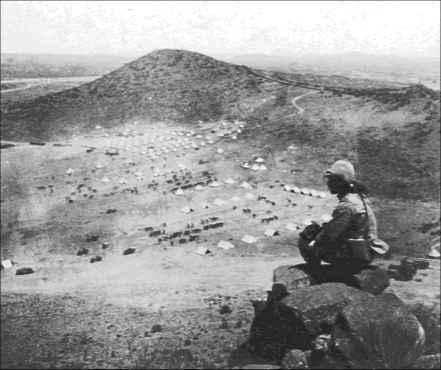
A solidier of the 2nd Battalion Worcestershire Regiment
looks down on Slingerfontein Camp from Worcester Hill
1st Battalion
1st Battalion move north with Rundle's Brigade |
On the 17th March 1900 the men of the 1st Battalion Worcestershire Regiment embarked at Southampton on the troop ship and headed for the war in South Africa as reinforcements for the British Army. On the 8th April 1900 the 1st Battalion disembarked at Cape Town and then made their way north with Rundle's Brigade towards Dewetsdorp. The Boers at this time were holding Dewetsdorp and Wepener. The British forces pushed the Boers north. During the action around Dewetsdorp some thirty of the 1st Worcesters wandered at night into the wrong line, and were made prisoners by the Boers. After this action the 1st Worcesters moved north-east and headed for Ladybrand. |
On the 2nd September 1900 a commando of Free State Boers under Fourie emerged from the mountain country on the Basutoland border, and attacked Ladybrand, which was held by a small garrison consisting of one company of the 1st Battalion Worcester Regiment and forty-three men of the Wiltshire Yeomanry. The Boers, who had several guns with them, seem to have been the same force which had been repulsed at Winburg only several days before on the 24th August 1900. The Worcesters beat back the Boers attack and held their line at Ladybrand for the next 4 days while waiting for British reinforcement to arrive. On the 5th September 1900 the Worcesters were finally relieved by Major-General Bruce Hamilton infantry of the 21st Brigade who had marched 80 miles in four and a half days. |
Boers attack Ladybrand which was held by the 1st Battalion Worcesters |
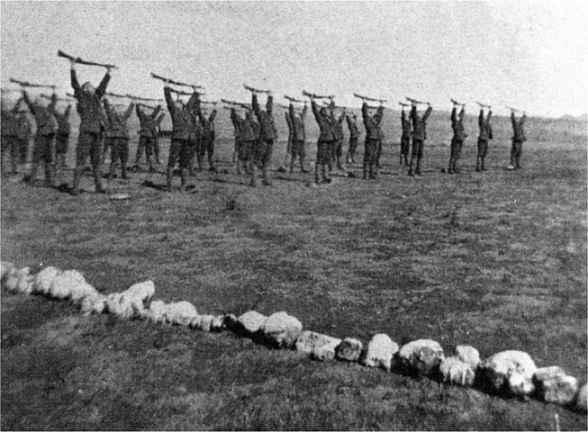
Men of 'B' Company, 1st Battalion Worcesters exercise in South Africa 1901
End of the First Phase
The first phase of the South African War—the heavy fighting between the opposing main armies—ended in the summer of 1900 with the defeat of the Boer forces and the occupation of Pretoria, their capital, by the British army under Lord Roberts; but the Boers did not give up the struggle. Dispersed in small Commandos,” well-armed, highly mobile, and operating over a vast and poorly-mapped country, they maintained for another two years a fierce guerilla warfare, attaching British posts, convoys, and lines of communication. To meet these attacks the British forces were reorganized, and many battalions of Mounted Infantry were formed by taking picked men from the Line Battalions. A Worcestershire Company was formed from personnel of the 1st and 2nd Battalions of the Worcestershire Regiment, and was grouped with companies of other regiments to form the 5th Battalion of Mounted Infantry. Two notable Worcestershire officers of this Company were Major (afterwards Colonel) W. D. Holland, who subsequently commanded the 1st Battalion during 1909-12 (one of the finest and best-loved Commanding Officers the Regiment has ever known), and Lieut. (afterwards Lieut.-Colonel) G. C. Lambton, who afterwards commanded the 2nd Battalion in the Great War 1914-19 at the battles of Festubert and Loos.
6th Battalion (Militia) |
Lord Roberts |
On the 18th December 1901 the men of the 6th Battalion (Militia) Worcestershire Regiment embarked at Southampton on the troop ship and headed for the war in South Africa. On the 18th January 1902 the Battalion disembarked at Cape Town.
4th Battalion
The 4th Battalion were not involved in any fighting and were sent to South Africa towards the end of the war to guard prisoners. On the 18th February 1902, 16 officers and 411 men of the 4th Battalion Worcesteshire Regiment boarded the Harlech Castle to sail to South Africa.
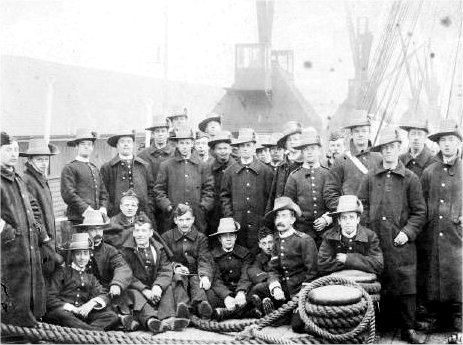
4th Battalion men on board the Harlech Castle
(photo courtesy of www.roll-of-honour.com)


